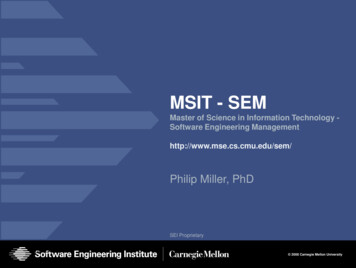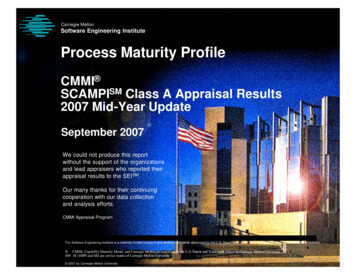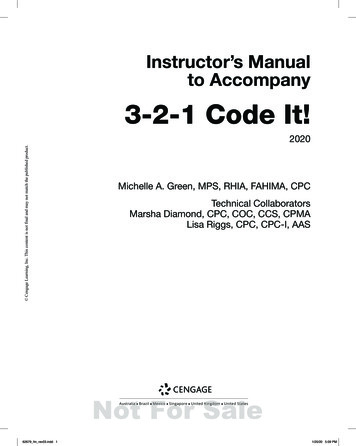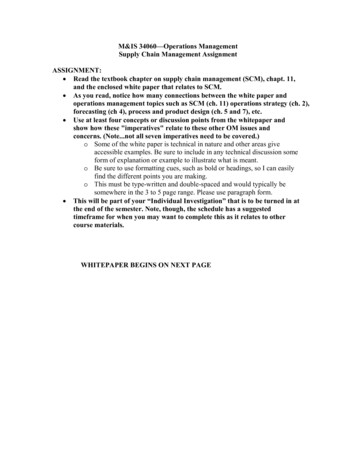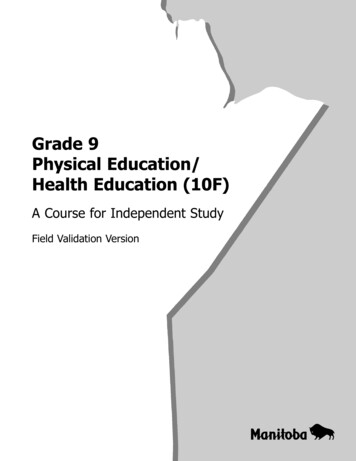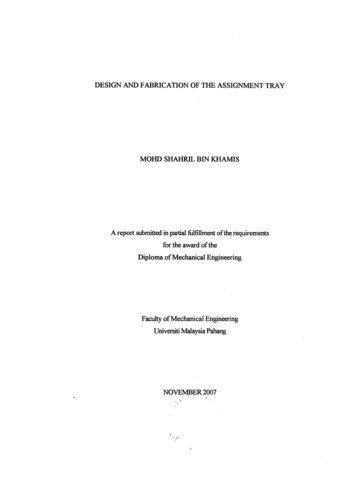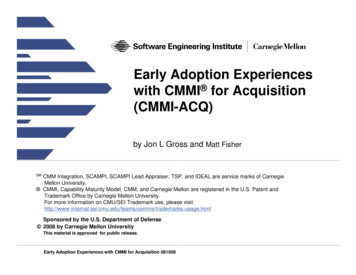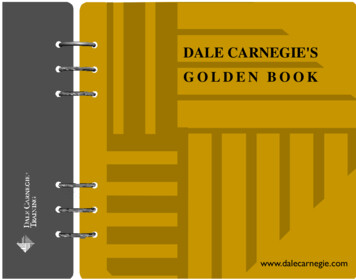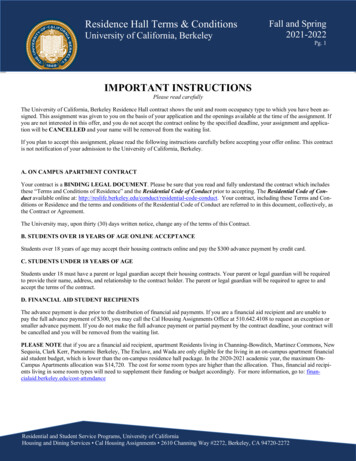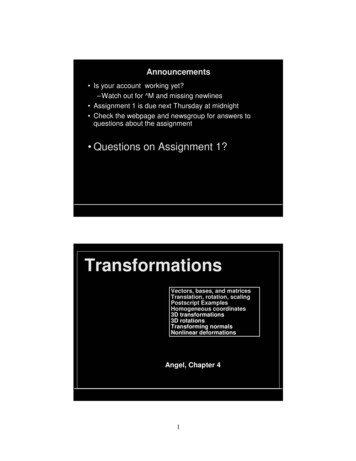
Transcription
Announcements Is your account working yet?–Watch out for M and missing newlines Assignment 1 is due next Thursday at midnight Check the webpage and newsgroup for answers toquestions about the assignment Questions on Assignment 1?TransformationsVectors,Vectors, bases,bases, andand matricesmatricesTranslation,Translation, rotation,rotation, scalingscalingPostscriptPostscript ExamplesExamplesHomogeneousHomogeneous coordinatescoordinates3D3D transformationstransformations3D3D rotationsrotationsTransformingTransforming normalsnormalsNonlinearNonlinear deformationsdeformationsAngel, Chapter 41
Uses of Transformations Modeling transformations– build complex models by positioning simple components– transform from object coordinates to world coordinates Viewing transformations– placing the virtual camera in the world– i.e. specifying transformation from world coordinates to cameracoordinates Animation– vary transformations over time to create motionCAMERAOBJECTWORLDGeneral TransformationsQ T(P) for pointsV R(u) for vectors2
Rigid Body TransformationsRotation angle and lineabout which to rotateNon-rigid Body Transformations3
Background Math: Linear Combinations of Vectors Given two vectors, A and B, walk any distance you likein the A direction, then walk any distance you like in theB direction The set of all the places (vectors) you can get to thisway is the set of linear combinations of A and B. A set of vectors is said to be linearly independent if noneof them is a linear combination of the others.VV v1 A v2B, (v1 ,v2 ) ABBases A basis is a linearly independent set of vectors whosecombinations will get you anywhere within a space, i.e.span the space n vectors are required to span an n-dimensional space If the basis vectors are normalized and mutuallyorthogonal the basis is orthonormal There are lots of possible bases for a given vector space;there’s nothing special about a particular basis—but ourfavorite is probably one of these.yzxyzx4
Vectors Represented in a Basis Every vector has a unique representation in agiven basis–the multiples of the basis vectors are the vector’scomponents or coordinates–changing the basis changes the components, but notthe vector–V v1E1 v2E2 vnEnThe vectors {E1, E2, , En} are the basisThe scalars (v1, v2, , vn) are the components of Vwith respect to that basisRotation and Translation of a Basis,,,5
Linear and Affine Maps A function (or map, or transformation) F is linear ifA BF(A B) F(A) F(B)F(kA) k F(A)Bfor all vectors A and B, and all scalars k.A Any linear map is completely specified by its effect on a set of basisvectors:V v1 E 1 v2 E 2 v3E 3F(V) F(v1E 1 v2E 2 v3E 3) F(v1E 1) F(v2E 2) F(v3E 3) v1F(E 1) v2F(E 2) v3F(E 3) A function F is affine if it is linear plus a translation– Thus the 1-D transformation y mx b is not linear, but affine– Similarly for a translation and rotation of a coordinate system– Affine transformations preserve linesTransforming a Vector The coordinates of the transformed basis vector (interms of the original basis vectors):F(E1) f11 E 1 f21 E 2 f31 E 3F(E2) f12 E 1 f22 E 2 f32 E 3F(E3) f13 E 1 f23 E 2 f33 E 3 The transformed general vector V becomes:F(V) v1F(E 1) v2 F(E 2) v3F(E 3) (f11 E 1 f21 E 2 f31 E 3)v1 (f12 E 1 f22 E 2 f32 E 3)v2 (f13 E 1 f23 E 2 f33 E 3)v3 (f11 v1 f12 v2 f13 v3)E 1 (f21 v1 f22 v2 f23 v3)E 2 (f31 v1 f32 v2 f33 v3)E 3and its coordinates (still w.r.t. E) arev1 (f11 v1 f12 v2 f13 v3)v2 (f21 v1 f22 v2 f23 v3)v3 (f31 v1 f32 v2 f33 v3)or justvi 6jfij vjThe matrix multiplication formula!6
Matrices to the Rescue An nxn matrix F represents a linear function in ndimensions– i-th column shows what the function does to the correspondingbasis vector Transformation linear combination of columns of F– first component of the input vector scales first column of thematrix– accumulate into output vector– repeat for each column and component Usually compute it a different way:– dot row i with input vector to get component i of output vector v1v2v3 f11 f12 f13f21 f22 f23f31 f32 f33v1v2v3vi 6jfij vjBasic 2D TransformationsTranslatex’ x txy’ y tyScalex’ s x xy’ s y yRotatex’ x cos T y sin Ty’ x sin T y cos Tª x’º ª x º ª t x º « y’» « y » « t » ¼ ¼ y ¼ ª x’º ª s x« y’» « 0 ¼ 0 º ª x º « » s y » ¼ y ¼ ª x’º ª cos T« y’» ¼ « sin Tx’ x tx’ Sx sin T º ª x º cos T » ¼ « y » ¼ Parameters t, s, and T are the “control knobs”7x’ Rx
Compound Transformations Build compound transformations by stringing basic ones together, e.g.– “translate p to the origin, rotate, then translate back”can also be described as a rotation about p Any sequence of linear transformations can be collapsed into a singlematrix formed by multiplying the individual matrices together6j fij 6k gjk vk 6k 6j fij gjk vkmij 6j fij gjkvi This is good: can apply a whole sequence of transformation at once0123Translate to the origin, rotate, then translate back.Postscript (Interlude) Postscript is a language designed for–Printed page description–Electronic documents A full programming language, with variables,procedures, scope, looping, –Stack based, i.e. instead of “1 2” you say “1 2 add” We’ll briefly look at graphics in Postscript–elegant handling of 2-D affine transformations andsimple 2-D graphics8
2D Transformations in Postscript, 10 0 moveto(test) showtest1 0 translate0 0 moveto(test) showtest30 rotate0 0 moveto(test) showtste2D Transformations in Postscript, 21 2 scale0 0 moveto(test) showtest1 0 translate30 rotate0 0 moveto(test) showtset930 rotate1 0 translate0 0 moveto(test) showtste
2D Transformations in Postscript, 330 rotate1 2 scale0 0 moveto(test) show1 2 scale30 rotate0 0 moveto(test) showtste t tes-1 1 scale0 0 moveto(test) showtsetHomogeneous Coordinates Translation is not linear--how to represent as a matrix? Trick: add extra coordinate to each vectorª x’º « y’» « » 1 ¼ ª 1 0 t x º ª x º « 0 1 t » « y » y« » « » 0 0 1 ¼ 1 ¼ This extra coordinate is the homogeneous coordinate, or w When extra coordinate is used, vector is said to berepresented in homogeneous coordinates Drop extra coordinate after transformation (project to w 1) We call these matrices Homogeneous Transformations10
W!? Where did that come from? Practical answer:–W is a clever algebraic trick.–Don’t worry about it too much. The w value will be 1.0for the time being.–If w is not 1.0, divide all coordinates by w to make itso. Clever Academic Answer:–(x,y,w) coordinates form a 3D projective space.–All nonzero scalar multiples of (x,y,1) form anequivalence class of points that project to the same2D Cartesian point (x,y).–For 3-D graphics, the 4D projective space point(x,y,z,w) maps to the 3D point (x,y,z) in the same way.Homogeneous 2D TransformationsThe basic 2D transformations becomeTranslate:Scale:Rotate:ª 1 0 tx º « 0 1 t » y« » 0 0 1 ¼ ª s x 0 0 º « 0 s 0 » y« » 0 0 1 ¼ ª cosT sinT 0 º « sinT cosT 0 » 01 » « 0¼ Any affine transformation can be expressed as acombination of these.We can combine homogeneous transforms bymultiplication.Now any sequence of translate/scale/rotate operationscan be collapsed into a single homogeneous matrix!11
Postscript and OpenGL TransformationsPostscriptEquivalent OpenGL(x’,y’)coord. sys.30 rotate1 0 translatedraw somethingglRotatef(30, 0,0,1);// rot 30 about z axisglTranslatef(1,0,0);draw something(x,y)coord. sys.ª x’º ªcosT« y ’» « sin T« » «« 1 »¼ « 0in this case T sin TcosT030q, t x0 º ª1 0 t x º ª x º0» «0 1 t y » « y »»« »»«1»¼ « 0 0 1 »¼ « 1 »¼1, t y 0Sequences of Transformationsx’ x’ x’ x’ x’ x’ x’ x’ x’TRANSFORMEDPOINTSMMx x x x x x x x x xUNTRANSFORMEDPOINTSMATRICESPARAMETERSM Often the sametransformations are applied tomany points Calculation time for thematrices and combination isnegligible compared to that oftransforming the points Reduce the sequence to asingle matrix, then transform12
Collapsing a Chain of Matrices. Consider the composite function ABCD, i.e. p’ ABCDp Matrix multiplication isn’t commutative - the order is important But matrix multiplication is associative, so can calculate from rightto left or left to right: ABCD (((AB) C) D) (A (B (CD))). Iteratively replace either the leading or the trailing pair by itsproductMmDM m CMM m BMM m AMPremultiplyMmAorM m MBM m MC both give thesame result.M m MD Postmultiply:Postmultiply: left-to-rightleft-to-right(reverse(reverse ofof ply:Premultiply: right-to-leftright-to-left(same(same asas iplyImplementing Transformation Sequences Calculate the matrices and cumulatively multiply them into a globalCurrent Transformation Matrix Postmultiplication is more convenient in hierarchies -- multiplicationis computed in the opposite order of function application The calculation of the transformation matrix, M,– initialize M to the identity– in reverse order compute a basic transformation matrix, T– post-multiply T into the global matrix M, M m MT Example - to rotate by T around [x,y]:glLoadIdentity()glTranslatef(x, y, 0)glRotatef(theta,0,0,1)glTranslatef(-x, -y, 0)/*/*/*/*initialize M to identity mat.*/LAST: undo translation */rotate about z axis */FIRST: move [x,y] to origin. */ Remember the last T calculated is the first applied to the points– calculate the matrices in reverse order13
Column Vector Convention The convention in the previous slides–transformation is by matrix times vector, Mv–textbook uses this convention, 90% of the world tooª x’º ª m11 m12 m13 º ª x º « y’» « m21 m22 m23 » « y » « » 1 » « ¼ 1 » ¼ m31 m 32 m 33 ¼ « The composite function A(B(C(D(x)))) is the matrixvector product ABCDxBeware: Row Vector Convention The transpose is also possible x’ª m11 m21 m 31 º x y 1 « m12 m22 m32 » « m» 13 m23 m 33 ¼ @ y’ 1@ How does this change things?–all transformation matrices must be transposed– ABCDx transposed is xTDTCTBTAT– pre- and post-multiply are reversed OpenGL uses transposed matrices!– You only notice this if you pass matrices as arguments toOpenGL subroutines, e.g. glLoadMatrix.– Most routines take only scalars or vectors as arguments.14
Rigid Body Transformations A transformation matrix of the formxx xy txyx yy ty0 0 1where the upper 2x2 submatrix is a rotation matrixand column 3 is a translation vector, is a rigidbody transformation. Any series of rotations and translations results ina rotation and translation of this formViewport Transformations A transformation maps the visible (model) world onto screen orwindow coordinates In OpenGL a viewport transformation, e.g. glOrtho(), defineswhat part of the world is mapped in standard “NormalizedDevice Coordinates” ((-1,-1) to (1,1)) The viewpoint transformation maps NDC into actual window,pixel coordinates– by default this fills the window– otherwise use glViewport(640,480)(4.7,2)(0,0)(2,0)15
3D Transformations 3-D transformations are very similar to the 2-D case Homogeneous coordinate transforms require 4x4matrices Scaling and translation matrices are simply:s0 0 0S 0 s1 00 0 s20 0 000011T 00001000010t0t1t21 Rotation is a bit more complicated in 3-D– left- or right-handedness of coordinate system affects direction ofrotation– different rotation axes3-D Coordinate Systems Right-handedvs.left-handedYY(into page)Z(out of page)XXZ Z-axis determined from X and Y by cross product: Z X YZXu Yª X 2Y3 X 3Y2 º«X Y X Y »1 3« 3 1»« X 1Y2 X 2Y1 »¼ Cross product follows right-hand rule in a right-handed coordinatesystem, and left-hand rule in left-handed system.16
Euler Angles for 3-D Rotations Euler angles - 3 rotations about each coordinate axis,however– angle interpolation for animation generates bizarre motions– rotations are order-dependent, and there are no conventions aboutthe order to use Widely used anyway, because they're “simple” Coordinate axis rotations (right-handed coordinates):Rx 100000cos –sinsin cos000001cos0Ry –sin0cos –sinsin cosRz 000000100100sin0cos00001Euler Angles for 3-D Rotations170001
Axis-angle rotationThe matrix R rotates by D about axis (unit) v:vv T cos D (I vv T ) sin Dv *Project onto vvvTRI vv TProject onto v ’s normal planev*Dual matrix. Project onto normal plane, flip by 90qcosD , sin DRotate by D in normal plane(assumes v is unit.)The Dual Matrix If v [x,y,z] is a vector, the skew-symmetric matrixv*ª 0 z y º « » z0 x« » « y x0 » ¼ is the dual matrix of v Cross-product as a matrix multiply: v*a v x a helps define rotation about an arbitrary axis angular velocity and rotation matrix time derivatives Geometric interpretation of v*a project a onto the plane normal to v rotate a by 90 about v resulting vector is perpendicular to v and a18
Quaternions Complex numbers can represent 2-D rotations Quaternions, a generalization of complex numbers, canrepresent 3-D rotations Quaternions represent 3-D rotations with 4 numbers:– 3 give the rotation axis - magnitude is sin D/2– 1 gives cos D/2– unit magnitude - points on a 4-D unit sphere Advantages:– no trigonometry required– multiplying quaternions gives another rotation (quaternion)– rotation matrices can be calculated from them– direct rotation (with no matrix)– no favored direction or axis See Angel 4.11What is a Normal?Indication of outward facing directionfor lighting and shadingOrder of definition ofvertices in OpenGLRight hand ruleNote: GL conventions glFrontFace(GL CCW)glFrontFace(GL CW)19
Transforming Normals It’s tempting to think of normal vectors as being likeporcupine quills, so they would transform like points Alas, it’s not so, consider the 2D affine transformationbelow. We need a different rule to transform normals.Normals Do Not Transform Like Points If M is a 4x4 transformation matrix, then–To transform points, use p’ Mp, where p [x y z 1]T–So to transform normals, n’ Mn, where n [a b c 1]Tright?–Wrong! This formula doesn’t work for general M.20
Normals Transform Like PlanesA plane ax by cz dn p nT p 0, where n a b c d @ , p(a,b,c) is the plane normal, d is the offset.If p is transformed, how should n transform?To find the answer, do some magic :0 can be writtenT xyz 1@T0 nT Ip equation for point on plane in original spacenT (M 1M )p(nT M 1 )(Mp)ncT pc equation for point on plane in transformed spacepc Mp to transform pointnc (nT M 1 )TM1Tn to transform planeTransforming Normals - Cases For general transformations M that include perspective,use full formula (M inverse transpose), use the right d–d matters, because parallel planes do not transform toparallel planes in this case For affine transformations, d is irrelevant, can use d 0. For rotations only, M inverse transpose M, cantransform normals and points with same formula.21
Spatial Deformations Linear transformations–take any point (x,y,z) to a new point (x’,y’,z’)–Non-rigid transformations such as shear are“deformations” Linear transformations aren’t the only types! A transformation is any rule for computing (x’,y’,z’) as afunction of (x,y,z). Nonlinear transformations would enrich our modelingcapabilities. Start with a simple object and deform it into a morecomplex one.Bendy Twisties Method:–define a few simple shapes–define a few simple non-linear transformations(deformations e.g. bend/twist, taper)–make complex objects by applying a sequence ofdeformations to the basic objects Problem:–a sequence of non-linear transformations can not becollapsed to a single function–every point must be transformed by everytransformation22
Bendy TwistiesExample: Z-Taper Method:–align the simple object with the z-axis–apply the non-linear taper (scaling) function to alter itssize as some function of the z-position Example:–applying a linear taper to a cylinder generates a coneGeneral taper (f is anyfunction you want):“Linear” taper:x’y’k1z k 2 xx’ f (z)xk1z k 2 yy’ f (z)yz’ zz’ z23
Example: Z-twist Method:–align simple object with the z-axis–rotate the object about the z-axis as a function of z Define angle, T, to be an arbitrary function f (z) Rotate the points at z by T f (z)“Linear” version:f (z)kzT f (z)x’ x cos(T) y sin(T)y’ x sin(T) y cos(T)z’ zExtensions Incorporating deformations into a modeling system– How to handle UI issues? “Free-form deformations” for arbitrary warping of space– Use a 3-D lattice of control points to define Bezier cubics:(x’,y’,z’) are piecewise cubic functions of (x,y,z)– Widely used in commercial animation systems Physically based deformations– Based on material properties– Reminiscent of finite element analysis24
A function (or map, or transformation) F is linear if for all vectors A and B, and all scalars k. Any linear map is completely specified by its effect on a set of basis vectors: A function F is affine if it is linear plus a translation - Thus the 1-D transformation y mx b is not linear, but affine

